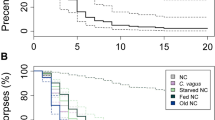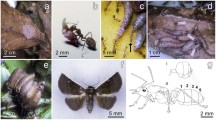Summary
Food robbing is a special form of interference competition in ants. It has been frequently observed in Myrmecocystus mimicus, which waylay returning foragers of several Pogonomyrmex species at their nests and take insect prey, particularly termites, away from them. Myrmecocystus more successfully robs prey from P. desertorum and P. maricopa than from P. barbatus. Usually only those Pogonomyrmex nests are affected by Myrmecocystus prey robbing that are not farther away than 10 m from the Myrmecocystus nest. Some M. mimicus workers show a high specialization in prey robbing. Other cases of food robbing in ants are described.
Similar content being viewed by others
References
Abe T (1971) On the food sharing among four species of ants in a sandy grassland. I. Food and foraging behavior. Jap J Ecol 20:219–230
Adams ES, Traniello JFA (1981) Chemical interference competition by Monomorium minimum (Hymenoptera: Formicidae). Oecologia (Berlin) 51:265–270
Davidson D (1980) Some consequences of diffuse competition in a sesert ant community. Am Nat 116:92–105
Forel A (1901) Fourmis termitophages, lestobiose, Atta tardigrada, sous-genres d'Euponera. Ann Soc Ent Belg 45:389–398
Hölldobler B (1973) Chemische Strategien beim Nahrungserwerb der Diebsameise (Solenopsis fugax Latr.) und Pharaoameise (Monomorium pharaonis L.). Oecologia (Berlin) 11:371–380
Hölldobler B (1976) Recruitment behavior, home range orientation, and territoriality in harvester ants, Pogonomyrmex. Behav Ecol Sociobiol 1:3–44
Hölldobler B (1979) Territories of the African weaver ant Oecophylla longinoda [Latraille]: A field study Z Tierpsychol 51:201–213
Hölldobler B (1981) Foraging and spatiotemporal territories in the honey ant Myrmecocystus mimicus Wheeler (Hymenoptera: Formicidae). Behav Ecol Sociobiol 9:301–314
Hölldobler B (1982) Interference strategy of Iridomyrmex pruinosum (Hymenoptera: Formicidae) during foraging. Oecologia (Berlin) 52:208–213
Hölldobler B (1983) Chemical manipulation, enemy specification and intercolony communication in ant communities. In: Huber F, Markl H (eds) Neuroethology and Behavioral Physiology. Springer, Berlin Heidelberg, pp 354–365
Hölldobler B (1986) Liquid food transmission and antennation signals in ponerine ants. J Israel Entomol Soc (in press)
Hölldobler B, Stanton RC, Markl H (1978) Recruitment and food retrieving behavior in Novomessor (Hymenoptera: Formicidae) I. Chemical signals. Behav Ecol Sociobiol 4:163–181
Markl H, Hölldobler B (1978) Recruitment and food-retrieving behavior in Novomessor (Formicidae, Hymenoptera). II. Vibrational signals. Behav Ecol Sociobiol 4:183–216
Maschwitz U, Mühlenberg M (1973) Camponotus rufoglaucus, eine wegelagernde Amerise. Zool Anz 191:364–368
Möglich MHJ, Alpert GD (1979) Stone dropping by Conomyrma bicolor (Hymenoptera: Formicidae): A new technique of interference competition. Behav Ecol Sociobiol 6:105–113
Traniello JFA (1983) Social organization and foraging success in Lasius neoniger (Hymenoptera: Formicidae): behavioral and ecological aspects of recruitment communication. Oecologia (Berlin) 59:94–100
Weber NA (1946) Two common ponerine ants of possible economic significance, Ectatomma tuberculatum (Olivier) and E. ruidum Roger. Proc Ent Soc Wash 48:1–16
Wheeler WM (1910) Ants, their structure, development and behaviour. Columbia Univ Press, New York
Wheeler WM (1936) Ecological relations of ponerine and other ants to termites. Proc Amer Acad Arts Sci 71:159–243
Wroughton RC (1982) Our ants. J Bombay Nat Hist Soc 1892:13–60
Author information
Authors and Affiliations
Rights and permissions
About this article
Cite this article
Hölldobler, B. Food robbing in ants, a form of interference competition. Oecologia 69, 12–15 (1986). https://doi.org/10.1007/BF00399031
Received:
Issue Date:
DOI: https://doi.org/10.1007/BF00399031




